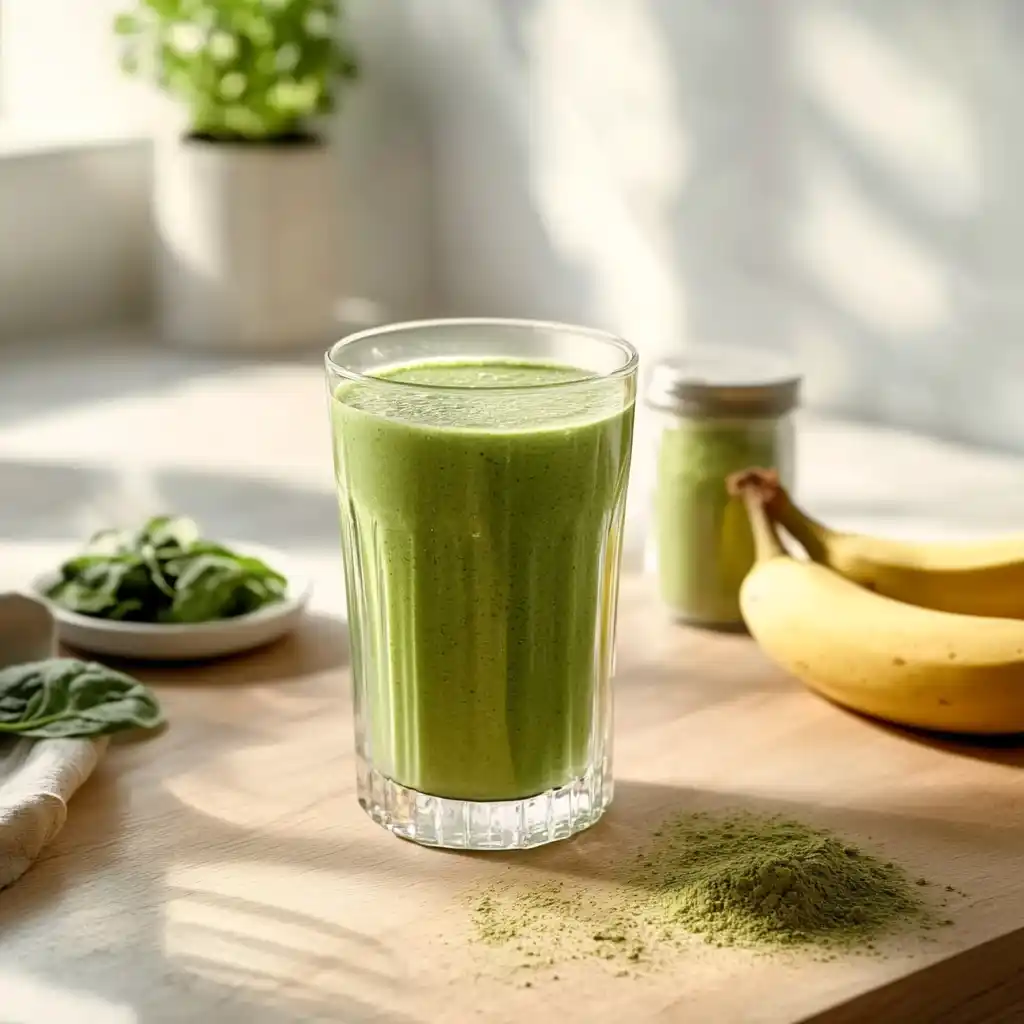A matcha green tea smoothie is more than a health trend — it’s a refreshing, energizing drink packed with antioxidants and flavor. By blending matcha with fruits, nut milks, and nutrient-dense ingredients, this smoothie becomes a powerful addition to any wellness routine.
My love for food began in a small sunlit kitchen by the coast, where I learned that meals could say what words sometimes can’t. Raised by women who believed cooking was a way of sharing love, I grew up believing every recipe should tell a story. This matcha green tea smoothie is one of mine — created on a calm morning when I wanted to feel refreshed, focused, and nourished.
Whether you’re after clean energy or simply enjoy a creamy, earthy flavor, a matcha green tea smoothie offers both taste and benefits in every sip.
Looking for inspiration? Try our Low-Calorie Iced Matcha Latte.
Table of Contents
Introduction to Matcha Green Tea Smoothies
What is a matcha green tea smoothie?
A matcha green tea smoothie blends matcha powder — finely ground green tea leaves — with nutrient-packed ingredients like bananas, spinach, oat milk, or chia seeds. Unlike steeped green tea, matcha gives you the full leaf and delivers a more concentrated source of antioxidants, natural caffeine, and earthy flavor.
The smoothie’s creamy texture and mild sweetness make it a versatile option for breakfast, a midday pick-me-up, or even a light meal replacement.
Brief history and cultural relevance of matcha in beverages
Matcha dates back centuries to Zen monasteries in Japan, where it was used during meditation for sustained energy and mental clarity. Today, that same green powder has found its way into modern kitchens — especially in smoothies, where its flavor and health benefits shine.
Incorporating matcha into smoothies isn’t just smart — it’s part of a global movement toward mindful eating. The matcha green tea smoothie is where tradition meets nutrition in the most delicious way.
Print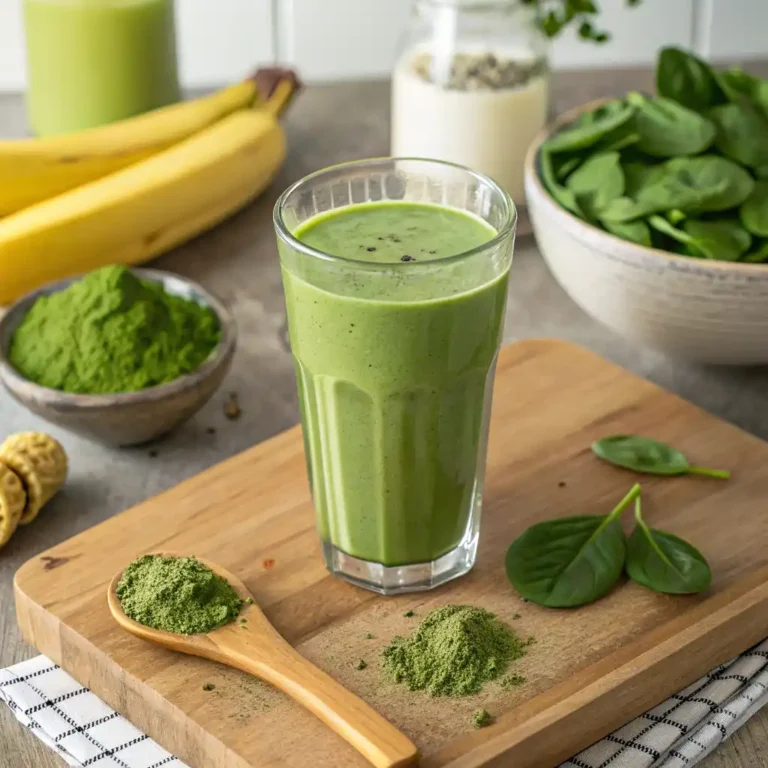
Matcha Green Tea Smoothie – Health Benefits, Recipes, and Daily Use Guide
A matcha green tea smoothie that blends earthy flavor with creamy texture, packed with antioxidants, clean energy, and nutrient-rich ingredients.
- Total Time: 5 minutes
- Yield: 1 serving
Ingredients
- 1 tsp high-quality matcha powder
- 1 frozen banana
- 1/2 cup unsweetened almond milk
- 1/4 cup Greek yogurt or plant-based yogurt
- 1 tsp honey or maple syrup (optional)
- 1 tbsp chia seeds
- Handful of spinach (optional)
- 2–3 ice cubes
Instructions
- Add all ingredients to a high-speed blender.
- Blend for 30–45 seconds until smooth and creamy.
- Adjust thickness with more milk or ice if needed.
- Pour into a chilled glass and enjoy fresh.
Notes
Use ceremonial grade matcha for a smoother taste, or culinary grade for everyday blends. For caffeine-sensitive individuals, start with ½ tsp matcha.
- Prep Time: 5 minutes
- Cook Time: 0 minutes
- Category: Smoothie
- Method: Blended
- Cuisine: Healthy
Check out our Ultimate Matcha Tea Guide for more matcha inspiration.
Health Benefits of Matcha Green Tea Smoothies
How matcha supports energy, focus, and metabolism
One of the biggest reasons people reach for a matcha green tea smoothie is for that clean, focused energy it delivers — without the crash you often get from coffee. The secret? A combination of natural caffeine and L-theanine, an amino acid that smooths out caffeine’s impact, helping you stay alert yet calm.
Matcha has about one-third the caffeine of coffee, but thanks to the L-theanine, its effects are more stable and sustained. When you blend it into a smoothie with fruits, fiber, and protein, it becomes a slow-release fuel source — ideal for mornings, pre-workouts, or even afternoon slumps.
Studies have also shown that matcha may increase thermogenesis, which means your body burns calories more efficiently. That makes the matcha green tea smoothie a smart choice for anyone supporting weight management or active lifestyles.
Antioxidants and detox properties of matcha in smoothies
Matcha is rich in catechins, a powerful class of antioxidants that helps the body fight oxidative stress and reduce inflammation. The most notable of these catechins is EGCG (epigallocatechin gallate), which supports cellular health and immune function.
When matcha is blended into a smoothie, its detoxifying benefits are amplified by fiber-rich fruits like bananas, berries, or leafy greens. This combo helps flush out toxins, supports digestion, and boosts your body’s natural cleansing processes.
Here’s a quick look at the antioxidant power of matcha compared to other common ingredients:
| Ingredient | ORAC Score (antioxidant value) |
|---|---|
| Matcha (1g) | 1,573 |
| Blueberries (100g) | 4,669 |
| Spinach (100g) | 1,513 |
| Green tea (brewed) | 253 |
As you can see, even a small amount of matcha brings a significant antioxidant punch to your smoothie.
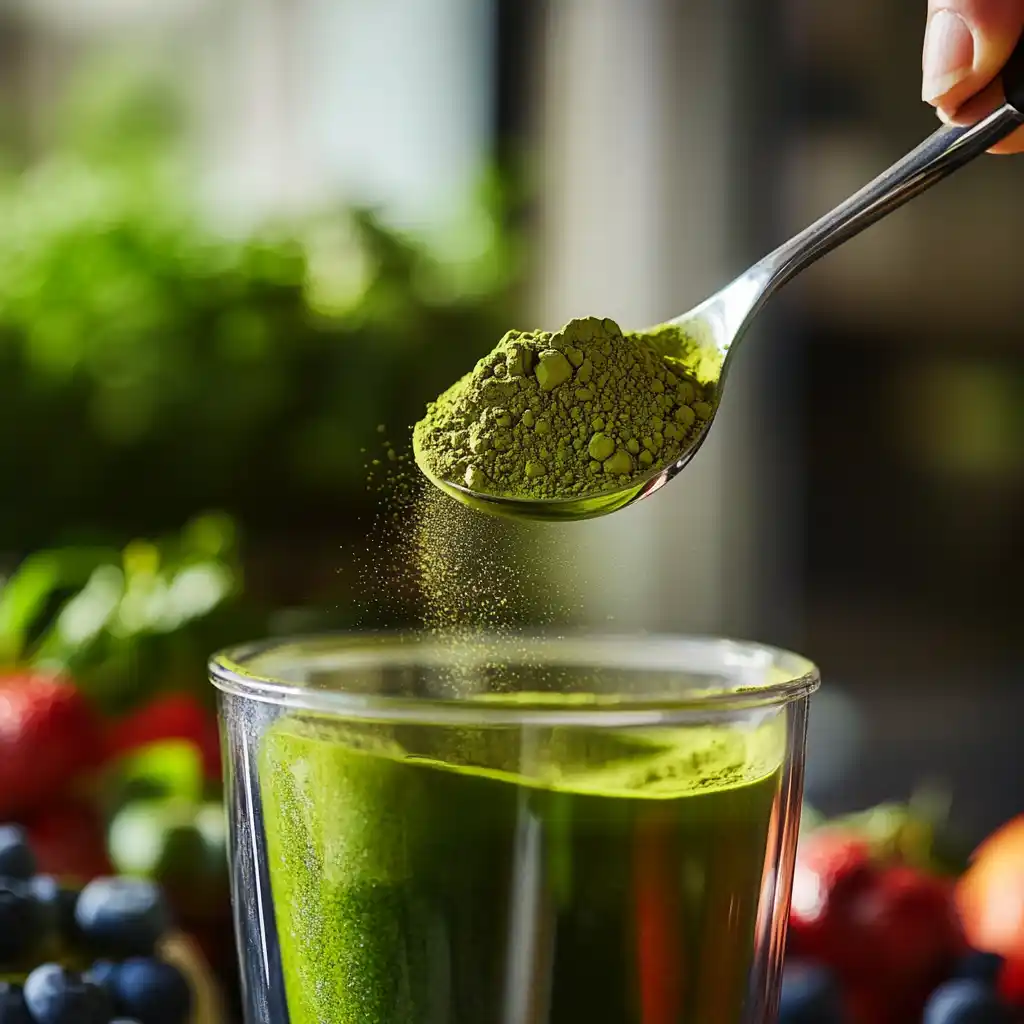
Health Benefits of Matcha Green Tea Smoothies
How matcha supports energy, focus, and metabolism
One of the biggest reasons people reach for a matcha green tea smoothie is for that clean, focused energy it delivers — without the crash you often get from coffee. The secret? A combination of natural caffeine and L-theanine, an amino acid that smooths out caffeine’s impact, helping you stay alert yet calm.
Matcha has about one-third the caffeine of coffee, but thanks to the L-theanine, its effects are more stable and sustained. When you blend it into a smoothie with fruits, fiber, and protein, it becomes a slow-release fuel source — ideal for mornings, pre-workouts, or even afternoon slumps.
Studies have also shown that matcha may increase thermogenesis, which means your body burns calories more efficiently. That makes the matcha green tea smoothie a smart choice for anyone supporting weight management or active lifestyles.
Antioxidants and detox properties of matcha in smoothies
Matcha is rich in catechins, a powerful class of antioxidants that helps the body fight oxidative stress and reduce inflammation. The most notable of these catechins is EGCG (epigallocatechin gallate), which supports cellular health and immune function.
When matcha is blended into a smoothie, its detoxifying benefits are amplified by fiber-rich fruits like bananas, berries, or leafy greens. This combo helps flush out toxins, supports digestion, and boosts your body’s natural cleansing processes.
Here’s a quick look at the antioxidant power of matcha compared to other common ingredients:
| Ingredient | ORAC Score (antioxidant value) |
|---|---|
| Matcha (1g) | 1,573 |
| Blueberries (100g) | 4,669 |
| Spinach (100g) | 1,513 |
| Green tea (brewed) | 253 |
As you can see, even a small amount of matcha brings a significant antioxidant punch to your smoothie.
Key Nutrients in Matcha Green Tea Smoothie
Breakdown of essential vitamins, minerals, and L-theanine
A matcha green tea smoothie isn’t just trendy — it’s nutritionally dense. At its core, matcha delivers a potent blend of antioxidants, but it also contains essential nutrients your body craves.
Let’s break down what a teaspoon of matcha powder brings to your glass:
- L-theanine: Promotes mental clarity and stress reduction
- Vitamin C: Supports immunity and skin health
- Vitamin A (from beta-carotene): Great for eye health
- Iron: Helps oxygenate your blood
- Potassium: Regulates fluid balance and supports heart function
- Chlorophyll: Naturally detoxifies the body
When you mix matcha with bananas, spinach, avocado, almond milk, or Greek yogurt, your matcha green tea smoothie becomes a nutrient powerhouse — delivering fiber, healthy fats, and protein all in one.
And here’s a quick visual of what a nutrient-packed smoothie might include:
| Ingredient | Nutrient Highlight |
|---|---|
| Matcha Powder | L-theanine, antioxidants |
| Banana | Potassium, fiber |
| Spinach or Kale | Iron, vitamin K |
| Greek Yogurt or Tofu | Protein, probiotics |
| Almond Milk (unsweet.) | Calcium, vitamin E |
| Chia or Flax Seeds | Omega-3, fiber |
Check out our Healthy Smoothie Recipes for more combinations packed with nutrition.
Calorie profile and macronutrient comparison with other smoothies
Compared to high-sugar fruit smoothies or dairy-heavy blends, the matcha green tea smoothie stands out as a cleaner, lower-calorie option — especially if made with plant-based milk and no added sweeteners.
Here’s a sample nutrition breakdown for a basic 12 oz matcha smoothie:
- Calories: 150–200
- Protein: 5–12g (depending on yogurt or added protein)
- Fat: 3–7g (from seeds or milk)
- Carbs: 18–25g (from fruit and greens)
- Sugar: 8–14g (mostly natural from fruit)
This balanced profile makes it ideal for breakfast, a light meal, or a smart post-workout refuel. With minimal sugar spikes and a long-lasting energy curve, it checks both the health and taste boxes.
Looking for variety? Don’t miss our Banana Trail Mix Breakfast Bars to pair with your smoothie.
Best Ingredients to Blend with Matcha
Fruits that complement matcha: banana, mango, berries
The earthy, slightly grassy taste of matcha can be perfectly balanced with the right fruits — and that’s what makes a matcha green tea smoothie so versatile and delicious. While matcha is bold on its own, pairing it with naturally sweet fruits rounds out the flavor and enhances the experience.
Here are top fruit options that work beautifully with matcha:
| Fruit | Why It Works |
|---|---|
| Banana | Creamy, mild, and naturally sweet |
| Mango | Tropical richness balances matcha’s earthiness |
| Blueberries | Antioxidant boost + color contrast |
| Pineapple | Tart and refreshing |
| Avocado | Adds creaminess, healthy fats, and no sugar |
| Dates | Natural sweetener for thicker smoothies |
These fruits not only improve taste, but they also bring fiber, vitamins, and natural sugars that give your matcha green tea smoothie an energy-boosting edge.
Want to go tropical? Try frozen pineapple with coconut milk and matcha — a refreshing blend perfect for summer mornings.
Discover great combos in our Green Detox Smoothie, packed with greens and fruity balance.
Add-ins for enhanced nutrition: chia seeds, Greek yogurt, almond milk
Want to level up your smoothie? Add-ins are where the real magic happens. They turn a simple drink into a complete, nutrient-dense meal — without sacrificing flavor or texture.
Here are some go-to additions for making your matcha green tea smoothie even better:
- Chia seeds or flax seeds: Boost fiber and omega-3s
- Greek yogurt or tofu: Adds protein and creaminess
- Unsweetened almond milk or oat milk: Low-calorie, smooth texture
- Honey or maple syrup (optional): Natural sweeteners to round off matcha’s bitterness
- Protein powder (vanilla or plain): Ideal post-workout
- Spinach or kale: Add greens without overwhelming taste
These additions help balance macros — especially when you’re aiming for a smoothie that supports weight loss, workout recovery, or meal replacement goals.
Don’t miss our Coconut Water Pineapple Smoothie for another refreshing base idea.
How to Make the Perfect Matcha Green Tea Smoothie
Step-by-step matcha smoothie recipe (classic version)
Making a matcha green tea smoothie at home is easier than you think — and with just a few quality ingredients, you’ll have a creamy, energizing drink ready in minutes.
Here’s a simple go-to recipe that’s both beginner-friendly and nutrient-dense:
Classic Matcha Green Tea Smoothie Recipe
Prep Time: 5 mins | Servings: 1
Ingredients:
- 1 tsp high-quality matcha powder
- 1 frozen banana
- 1/2 cup unsweetened almond milk (or oat milk)
- 1/4 cup Greek yogurt or plant-based yogurt
- 1 tsp honey or maple syrup (optional)
- 1 tbsp chia seeds
- Handful of spinach (optional for a green boost)
- Ice cubes (2–3, for texture)
Instructions:
- Add all ingredients to a high-speed blender.
- Blend until smooth and creamy (30–45 seconds).
- Pour into a chilled glass and enjoy immediately.
This blend is balanced in taste, texture, and nutrients — offering sustained energy, creamy satisfaction, and plenty of antioxidants in each sip.
Variations: high-protein, detox-friendly, or meal-replacement matcha smoothies
Want to customize your matcha green tea smoothie? Here are easy variations to fit your needs:
1. High-Protein Matcha Smoothie
Ideal for post-workout recovery
- Add 1 scoop vanilla protein powder
- Use 1/2 cup soy milk + 1/2 cup Greek yogurt
- Include 1 tbsp peanut butter or almond butter
2. Detox Matcha Green Tea Smoothie
Perfect for gut health and digestion
- Add 1/2 cucumber and juice from half a lemon
- Use coconut water instead of milk
- Include fresh mint leaves
3. Meal Replacement Matcha Smoothie
For busy mornings or on-the-go nutrition
- Use full-fat coconut milk for added calories
- Add 1/4 avocado and 2 tbsp oats
- Top with a sprinkle of granola for crunch
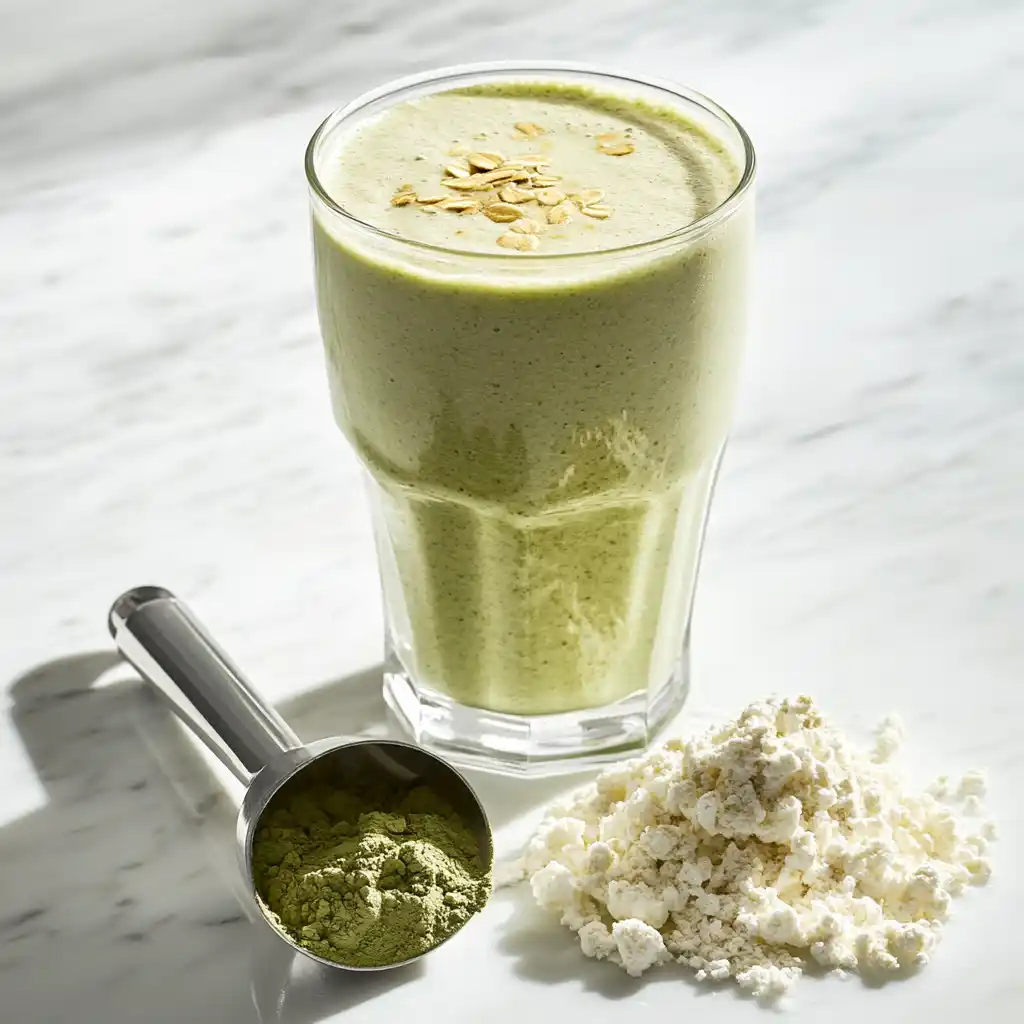
These variations help adapt the matcha green tea smoothie to your lifestyle, whether you’re powering through a workout, cleansing gently, or just need a satisfying meal in a glass.
Looking for more fuel options? Explore our Protein-Packed Berry Smoothie.
Can You Drink Matcha Green Tea Smoothies Every Day?
Recommended daily intake of matcha and its caffeine content
It’s natural to wonder whether having a matcha green tea smoothie daily is too much of a good thing. In most cases, the answer is no — it’s absolutely safe to enjoy matcha every day, as long as you’re mindful of your portion sizes.
A typical smoothie contains about 1 to 2 teaspoons of matcha powder. That provides roughly 35–70 mg of caffeine — less than a cup of coffee but enough for a gentle energy lift. Thanks to matcha’s unique combination of caffeine and L-theanine, it delivers sustained focus without the jittery side effects.
According to dietitians, the recommended daily intake of matcha is about 2–3 teaspoons per day, depending on your tolerance to caffeine and existing health conditions. That means enjoying one matcha green tea smoothie per day is well within safe and beneficial limits.
Of course, everyone’s body reacts differently to caffeine. If you’re sensitive, consider reducing the matcha to 1/2 tsp and pairing it with low-sugar fruits or calming herbs like mint or basil.
Who should limit matcha consumption? Safety guidelines and side effects
While matcha is safe for most people, there are a few situations where moderation is key — especially when consuming it daily in a smoothie.
You may want to limit matcha if you:
- Are pregnant or breastfeeding: Due to its caffeine content, consult your doctor first.
- Have iron absorption issues: Matcha’s tannins can mildly affect how your body absorbs iron from plant foods.
- Have anxiety or heart sensitivity to caffeine: The caffeine in a matcha green tea smoothie may still affect sensitive individuals.
- Are on blood pressure or blood-thinning medications: Matcha contains vitamin K, which can interfere with certain medications.
Common side effects of excess matcha:
- Digestive upset or nausea if consumed in large amounts on an empty stomach
- Headache or insomnia in caffeine-sensitive individuals
- Rare allergic reactions (though very uncommon)
But here’s the good news: These effects typically occur only with very high matcha intake — far more than what you’d use in a single smoothie.
If you stay within a teaspoon or two per serving and listen to your body, drinking a matcha green tea smoothie daily can be a healthy, energizing habit.
Check out our Chia Water Recipe for another gentle, detoxifying beverage.
Matcha Green Tea in Your Daily Smoothie Routine
Best times to drink a matcha smoothie (morning vs. afternoon)
Timing can make a big difference when it comes to getting the most out of your matcha green tea smoothie. Thanks to its steady energy boost and brain-enhancing effects, matcha is best enjoyed during the morning or early afternoon.
Here’s why:
- Morning: A matcha smoothie first thing in the morning gives your body an antioxidant boost and mental clarity — without the harsh crash of coffee.
- Midday: If you often feel sluggish after lunch, this smoothie can offer the right lift to help you power through the rest of your day.
Because matcha contains caffeine, avoid drinking it too close to bedtime — usually after 3:00 p.m. — especially if you’re sensitive to stimulants.
For those practicing intermittent fasting, a matcha green tea smoothie can be a great first meal to gently break the fast. It’s light but satisfying and won’t spike your blood sugar like sugary snacks might.
Don’t miss our Green Tea Drink Recipe for a Healthy Boost to support your daily wellness rhythm.
Pairing smoothies with workouts or intermittent fasting
Whether you’re looking to burn fat or fuel a workout, a matcha green tea smoothie fits naturally into active lifestyles. Here’s how to time it:
Before a workout:
Drink your smoothie about 30–45 minutes before exercise for a caffeine kick that improves endurance and focus. Add bananas or oats for natural carbs and matcha’s thermogenic benefits to help you burn more fat.
After a workout:
Make it a recovery drink by blending in protein powder, Greek yogurt, or nut butter. This helps repair muscle tissue and replenish energy stores while supporting your metabolism.
During intermittent fasting:
Break your fast with a lower-calorie version (matcha, almond milk, spinach, a small banana). It won’t spike insulin and can gently reintroduce nutrients after fasting.
Daily routines are personal, but incorporating a matcha green tea smoothie in one of these time slots can help make the most of its clean energy, fat-burning potential, and brain-boosting effects.
For more power-packed recipes, don’t miss our Protein-Packed Berry Smoothie.
Tips for Buying and Storing Matcha Powder
Types of matcha: ceremonial vs. culinary grade
Choosing the right matcha makes all the difference in the taste and quality of your matcha green tea smoothie. If you’ve ever wondered why some smoothies taste bitter or dull, it likely comes down to the grade of matcha used.
There are two main types of matcha powder on the market:
1. Ceremonial Grade Matcha
- Made from the youngest tea leaves
- Vibrant green color and slightly sweet, grassy flavor
- Best for drinking straight (e.g., in tea or high-quality smoothies)
- More expensive but smoother in taste
2. Culinary Grade Matcha
- Made from slightly older leaves
- Stronger, more bitter flavor (great for baking or lattes)
- Lower cost and blends well with bold ingredients
- Ideal for everyday use in matcha green tea smoothies
For smoothies, culinary grade matcha is often the better choice — especially when paired with sweet fruits or nut milk. But if you’re looking for a smoother, more premium experience, ceremonial matcha can elevate your recipe.
Don’t miss our Iced Strawberry Matcha Latte Recipe for a beautifully balanced flavor using top-quality matcha.
How to store matcha to preserve flavor and nutrients
Matcha is delicate — light, air, moisture, and heat can quickly degrade its nutrients and flavor. So, how you store it really matters.
Here are tips to keep your matcha fresh and potent:
- Keep it airtight: Always reseal the pouch tightly or transfer to a small glass jar with a tight lid.
- Store in the fridge: Matcha stays fresher longer in a cool, dry place. The fridge is ideal if you use it regularly.
- Avoid moisture: Never scoop matcha with a wet spoon or let it sit near a steaming kettle.
- Use within 1–2 months: Once opened, matcha starts to lose its vibrancy over time. Buy in small batches if possible.
Bonus tip: If your matcha smells stale or looks yellowish instead of bright green, it’s probably time to replace it.
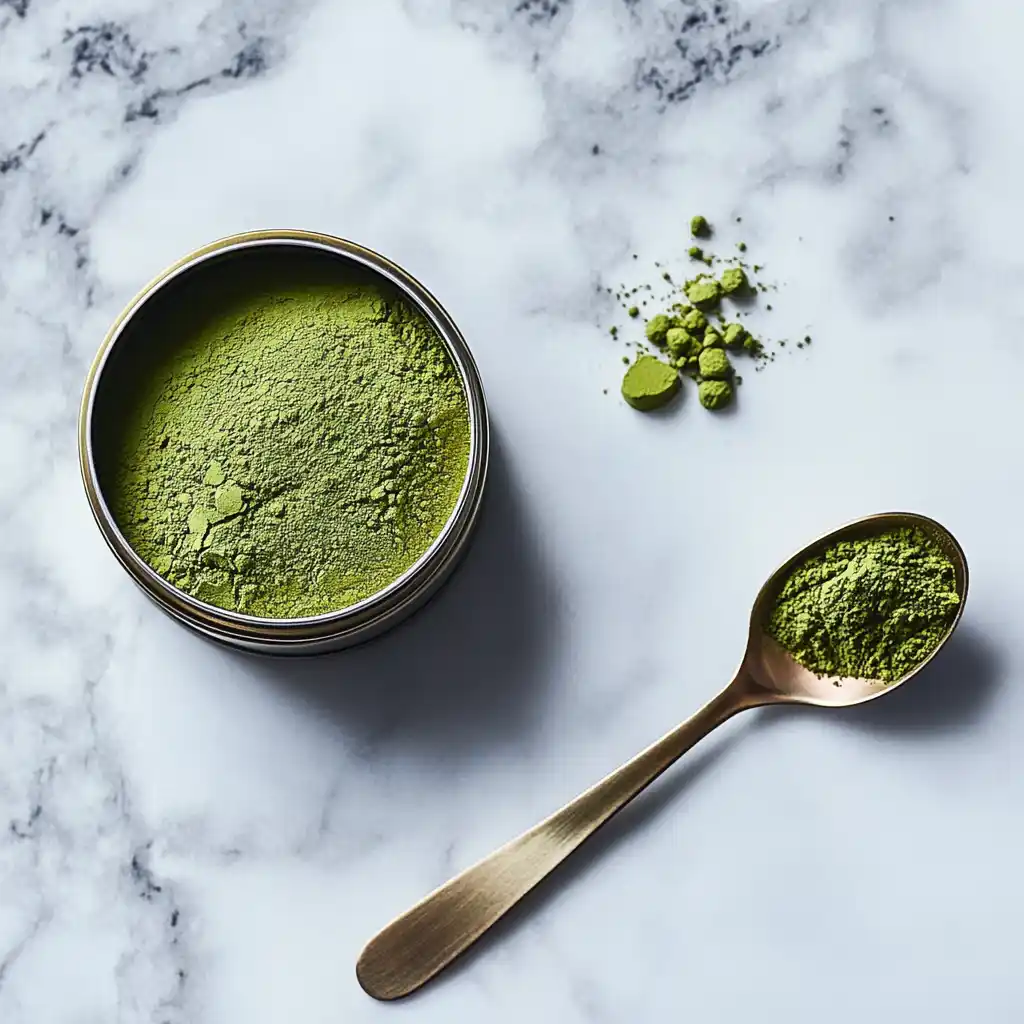
By storing your matcha properly, you’ll ensure every matcha green tea smoothie you make tastes fresh, smooth, and nutrient-rich.
Frequently Asked Questions About Matcha Green Tea Smoothies
Is matcha green tea smoothie good for you?
Whether you drink it for breakfast, post-workout, or as a midday pick-me-up, it’s one of the most beneficial smoothies you can enjoy.
Can matcha be added to smoothies?
Adding just one teaspoon of matcha to your smoothie can enhance mental focus, improve alertness, and give you a natural energy lift without caffeine jitters.
What fruit goes well with matcha green tea?
Bananas: Add creaminess and natural sweetness
Mango: Offers a tropical touch that balances matcha’s bitterness
Blueberries: Pack antioxidants and color
Pineapple: Refreshing and tangy, ideal for summer smoothies
Avocado: Not a fruit you’d expect, but it provides smooth texture and healthy fats
These fruits not only enhance taste but also increase the nutrient content of your matcha green tea smoothie.
Is it safe to drink matcha green tea every day?
However, if you’re sensitive to stimulants or have health conditions affected by caffeine or vitamin K, it’s wise to consult your doctor before making matcha a daily habit.
How much matcha should you add to a smoothie?
Does matcha in smoothies help with weight loss?
Just be sure to skip added sugars and focus on whole, nutrient-rich additions like leafy greens, berries, and protein.
Conclusion
A matcha green tea smoothie isn’t just a drink — it’s a lifestyle choice. With every sip, you’re embracing centuries of wellness wisdom combined with modern nutrition. Whether you’re seeking steady energy, glowing skin, improved focus, or just a delicious way to fuel your day, matcha delivers all that and more.
With the right ingredients, portion control, and creativity, you can enjoy a matcha green tea smoothie daily and make it part of a long-term healthy routine. From its antioxidant punch to its customizable flavors, this green powerhouse has earned its place at the top of your smoothie game.
Looking for a new smoothie to try? Discover our Coconut Water Pineapple Smoothie for a tropical twist.
For more recipe inspiration and visual guides, check out our curated boards on Pinterest.

